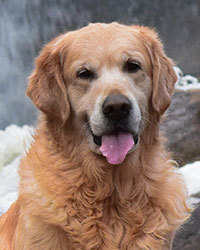Origin: Developed by Dudley Marjoribanks, later Lord Tweedmouth, near Inverness, Scotland between 1850 and 1890. His goal was to create a medium sized retriever that would be an effective worker on both upland game and waterfowl. The Golden was first registered as a distinct breed by the Kennel Club (UK) in 1913. A variety of styles have developed over time from leaner, less heavily coated working field dogs, to the gorgeous conformation dogs of both the UK and American rings.
Temperament: Friendly, reliable, and trustworthy. Goldens should not display hostility or aggressiveness towards other dogs or people, nor undue timidity or nervousness. They are ideally alert, eager, and self-confident
Weight: males 65-75 lbs; females 60-70 lbs
Height: males 23 – 24″ in height at withers; females, 21-1/2 – 22-1/2″
Colour: Various rich lustrous shades of gold. Feathering may be lighter than the predominant body colour and older dogs may display whitening of the face.
Coat: Fur is dense and water repellent with a good undercoat. Routine brushing is recommended, and feet and ears may be trimmed for tidiness. Sheds throughout the year, and the double coat will undergo significant shedding twice a year at which time more frequent brushing will be needed
Training: Goldens are highly intelligent; thrives on fair training and tends to be a quick learner. Their high intelligence makes it vital that owners provide structured training or they make their own fun and set their own boundaries. Their stable temperament makes them a premier service dog. They excel in multiple dog sports and many are successfully trained to work in obedience, agility, tracking, and hunt work. Buyers seeking a dog to engage in a particular sport should try to find a breeder whose dogs have excelled in that area
Crate training: Goldens take to crate training easily with positive associations, such as being fed or getting their toys in the crate. It is recommended that young Goldens be crated when they cannot be supervised as their intelligence, inquisitiveness, and tendency to explore their world with their mouths can get them into trouble with inappropriate chewing
Obedience: The Golden is among the top obedience competitors; 6 of the top 10 obedience dogs in 2014 were Goldens. Goldens typically have high intelligence combined with a keen desire to please their owners, and are capable of learning complex tasks and behaviours. They respond best to fair, balanced training that focuses on teaching with praise, rewards (food and/or toys) and directive feedback, and can resent harsh or unfair corrections.
Exercise/Activity: As an active sporting breed, Goldens require significant exercise. Most are not satisfied with a simple walk around the block, but need to run and play and have some mental stimulation in order to be happy. They particularly enjoy games/activities involving retrieving and swimming. The breed should also have an “off-switch” and be able to settle quietly when at home
Feeding: Goldens can thrive on a variety of diets from raw to high quality kibbles. They tend to love food, so portion control to prevent excess weight gain is important



